Day 1 of a weekend of Autumn Tours today. It was forecast to be cloudy all day, with rain expected early afternoon. Although largely correct for once, thankfully the rain held off until later than expected and meant we could get a good day out in the field.
As we drove east along the coast road at the start of the day, we had a quick look out at the cows on the grazing meadow east of Stiffkey village. There was no sign of the Cattle Egret, but this was not a surprise. This bird appears to be a late riser! We would have a proper look later.
Our first destination for the morning was Stiffkey Fen. As we walked down along the permissive path, three flocks of Goldfinches flew over, totalling about 60 birds. They might be locals, but there were finches on the move today so perhaps these were on their way somewhere too. A Redwing flew over ‘teezing’, and headed off inland. Two Stock Doves were feeding in the recently sown field. A helicopter flew over somewhere towards the coast, drowning out all the birds – we couldn’t see it but we could certainly hear it and it sounded low.
When the helicopter had passed, we could hear tits calling in the trees on the other side of the road, Long-tailed Tits and Blue Tits. As we set off down the footpath alongside the river, a Dunnock called from the trees and a Cetti’s Warbler shouted at us from the bushes.
There are a couple of places along the path where you can see over the reeds to the Fen and there looked to be a slightly disappointing number of birds on here today, particularly considering it was a big high tide in the harbour, which normally means birds come in here to roost. At that point we realised why, as the helicopter came back again, the other way. It was flying low over the north side of the Fen and spooked all the birds which were left. A lot of the ducks disappeared out towards the Harbour.
When we got up onto the seawall, we could see there was not much left on the Fen. There were still a few ducks – Wigeon, Teal, a couple of Gadwall and a few Shoveler – but not the number which should be here now. At first we could see next to no waders, apart from a couple of Ruff, but we heard Greenshanks calling and round in the corner we found a group of 21 of them asleep. With them were a few Redshank and Ruff and a handful of Black-tailed Godwits.
Because the tide was in, the channel and the harbour were full of water. We could see a line of roosting Oystercatchers on Blakeney Point, with a number of seals pulled out on the beach at the far end. On the near side of the harbour, a few more Oystercatchers were roosting on a spit with half a dozen Bar-tailed Godwits. Numbers of Brent Geese are steadily increasing for the winter now, and we could see a small group flying round further along towards Morston.
We stood on the seawall for a few minutes, scanning out towards the harbour. There were clearly birds moving today, though not in any great number. Two Skylarks flew high west. Two Yellowhammers flew past us too, but these were probably local birds and they dropped into the hedge further along. A Kingfisher called behind us and we turned to see it disappearing into the sallows along the river.
Birds were slowly returning to the Fen, but it was clear they probably wouldn’t come back in big numbers this tide now. A couple of flocks of Redshanks flew back in from the harbour, and two more Black-tailed Godwits. A large mob of Greylag Geese flew back in from the fields. We decided we would be better to head on somewhere else. As we started to walk back along the path, a large flock of Wigeon flew in over the seawall and circled over the Fen nervously, calling.
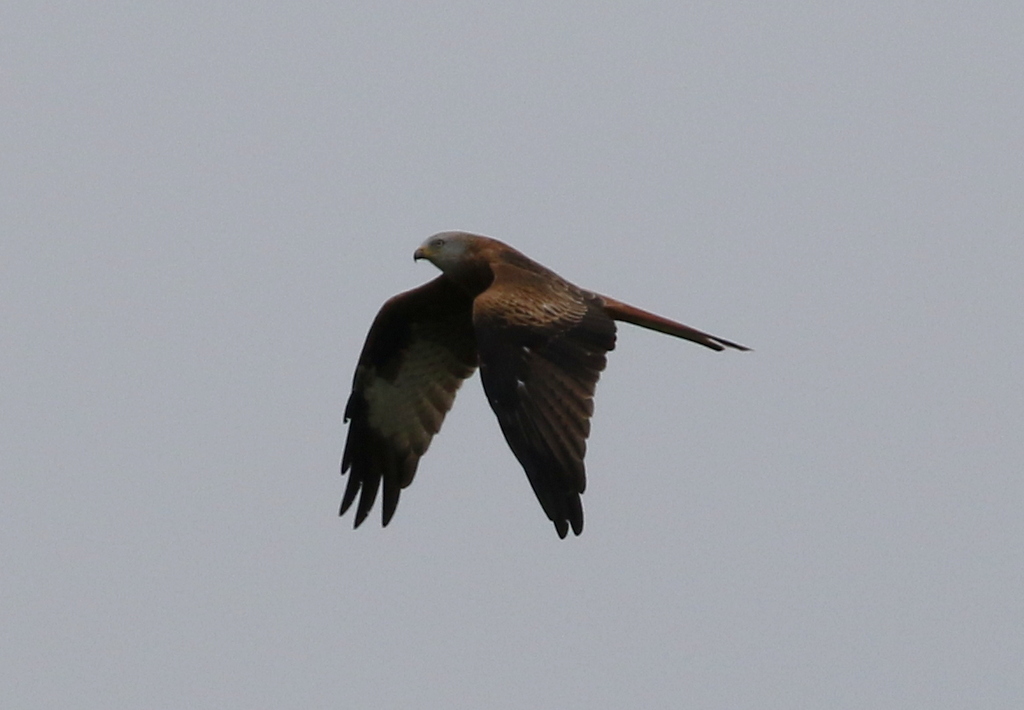 Red Kite – flew past us at Stiffkey Fen
Red Kite – flew past us at Stiffkey Fen
We looked back from the path across the water and noticed a large raptor circling over the small ridge to the east of the Fen. It was a Red Kite. It banked and turned towards us before flying lazily over the north edge of the Fen and straight past us, heading west.
The Cattle Egret tends to appear mid-morning and we had now reached the time when it should normally be with the cows. As we started walking down the path to see if it had arrived yet, some people coming the other way confirmed that it was there already. As soon as we got to the corner, we could see it – an obvious white shape out in the grass. We watched it for a while, walking around among the cows’ legs. One cow in particular was more active, and the Cattle Egret followed it closely for several minutes. Two Grey Herons among the cows too were much more static in their approach.
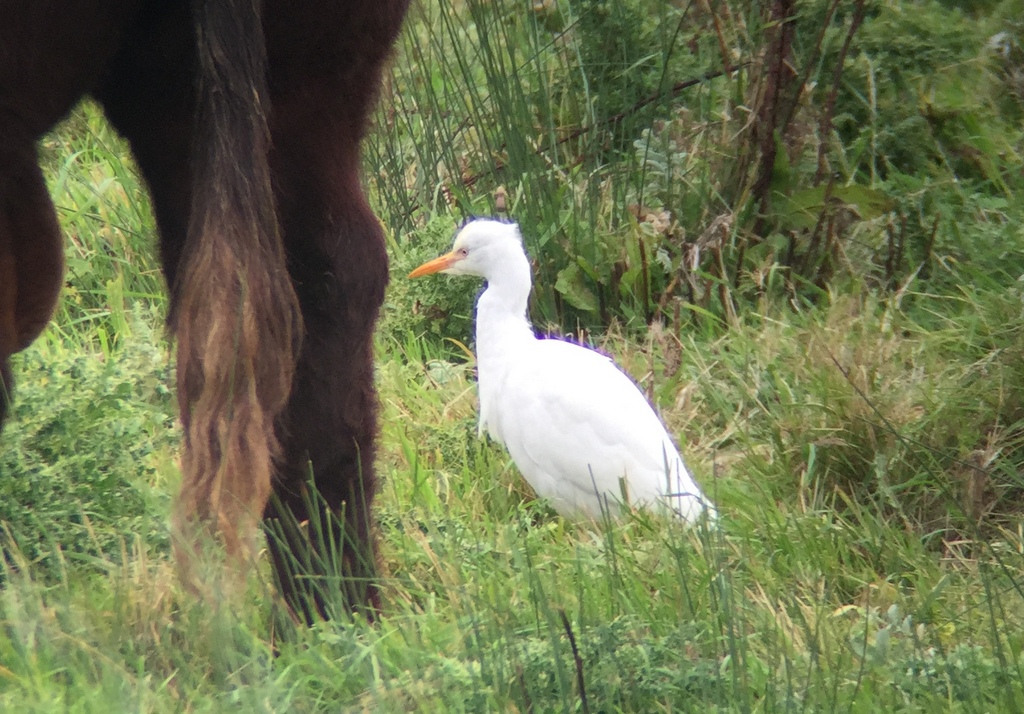 Cattle Egret – back feeding with the cows again mid morning
Cattle Egret – back feeding with the cows again mid morning
When two or three of the cows walked down into the edge of the wet ditch at the back of the field, the Cattle Egret quickly spotted them and flew over to join them. It walked down into the ditch and disappeared from view, so we decided to move on.
There had been a Red-necked Phalarope at Kelling for a few hours yesterday afternoon, but it had been flushed and flown off out to sea. At that point, news came through that it was back, so we decided to make our way straight round there, before it flew off again.
When we arrived in Kelling, there were lots of cars parked in the village – the phalarope was obviously proving a popular draw today. We had to park further up along the road, and as we got out of the car, we thought we could hear a Crossbill. It was just a couple of calls, but when we stopped to listen carefully, there was nothing. Perhaps we were mistaken. However, as we crossed the main coast road and started to walk into the lane, we heard the Crossbill again. There it was, perched in the top of the fir tree, a smart male.
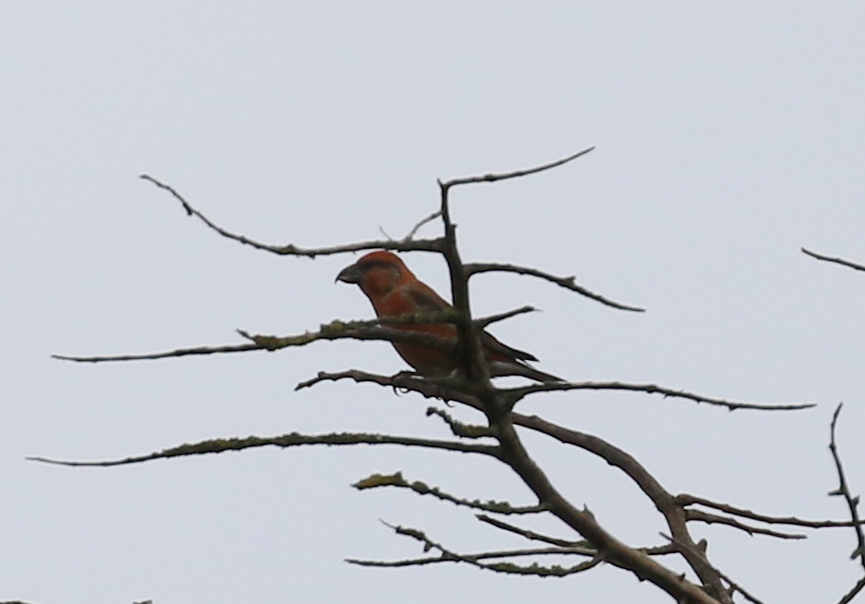 Common Crossbill – appeared briefly in the top of a fir tree in Kelling
Common Crossbill – appeared briefly in the top of a fir tree in Kelling
It stayed perched there for a couple of minutes, long enough for us to get a good look at it through scope. It was a Common Crossbill, a scarce bird here, probably dispersing in search for cones. We did look extra carefully, given the recent arrival of several rarer and larger-billed Parrot Crossbills into the Northern Isles, but we just confirmed what we already knew (Parrot Crossbill has a different call) – it was definitely a Common Crossbill. Then a Chaffinch flew up and chased it from its perch and the Crossbill disappeared.
There were a few Greenfinches and Chaffinches in the bushes along the lane. Three more Redwings flew over calling, and headed off inland. Several small groups of Pink-footed Geese flew over too, heading west, possibly fresh arrivals, just back for the winter from Iceland.
 Pink-footed Geese – several small groups flew over us this morning
Pink-footed Geese – several small groups flew over us this morning
Down at the Water Meadow, we found several people watching the Red-necked Phalarope. We had a quick look at it through the scope from the path, then round to the far corner which it seemed to be favouring for a closer look.
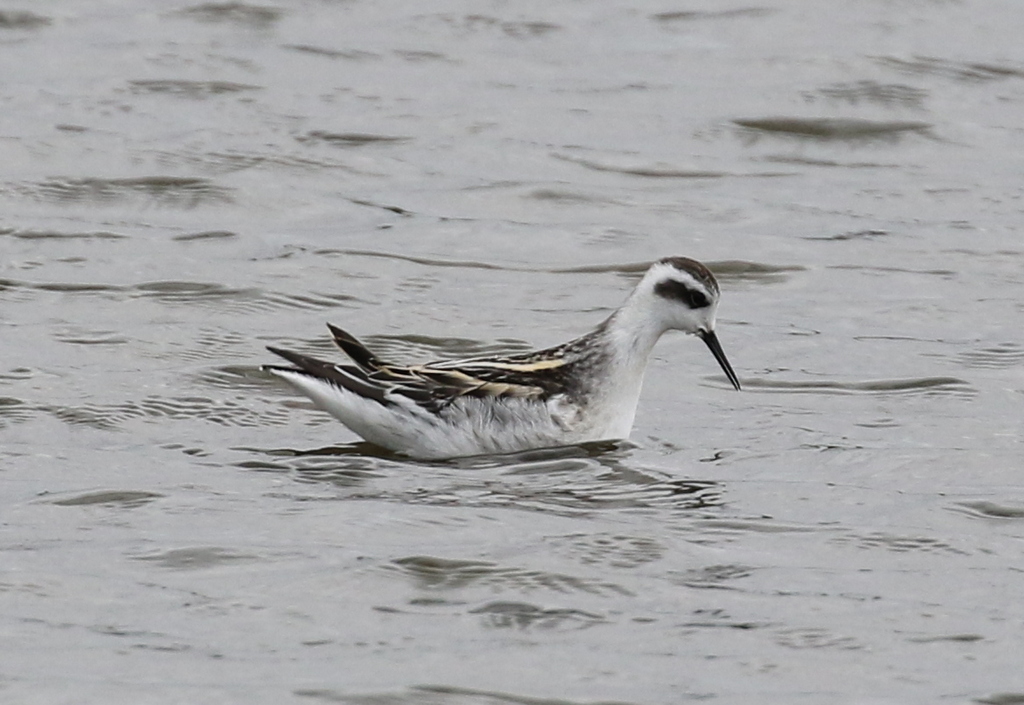 Red-necked Phalarope – we enjoyed great views of this juvenile at Kelling
Red-necked Phalarope – we enjoyed great views of this juvenile at Kelling
The Red-necked Phalarope was still in juvenile plumage, with a dark back marked with bold pale straw coloured lines. We watched it for a while, swimming, spinning round, picking for food which it stirred up to the surface. As we stood quietly, it gradually came closer giving us a great close view of it.
There were a few other birds around the Water Meadow. Two Common Snipe were preening in the rushes in the back corner, and several Redshank and a Ruff were feeding along the muddy edges. A Grey Heron was standing on the island in the middle. As the Red-necked Phalarope made its way steadily further back again, we decided to move on.
Just along the coast at Cley, a Grey Phalarope had been around since yesterday too, so we decided to head round to try to see that next, two phalaropes for the price of one. We parked at Walsey Hills and walked along to the East Bank, but when we got there we met another local birder walking back who told us it had just flown off. Very annoying, as it had seemed to be the more settled of the two phalaropes!
The Grey Phalarope had apparently headed off towards the reserve, so we went to Bishop Hide to see if it was on Pat’s Pool, as it had been on there at one point yesterday. As we walked along the path, we could hear Bearded Tits calling from the reeds the other side of the ditch. We turned to see four fly off across the tops of the reeds, but although there were still some calling nearby, they kept well tucked in out of the fresh breeze.
There was no sign of the Grey Phalarope on Pat’s Pool, but there were some other waders on here. We counted 9 Little Stints in one little group, all juveniles, and a single juvenile Curlew Sandpiper with them. There have been unusually large numbers of Little Stints here at Cley in the last week or so, up to 40 at one point. Presumably it was a good breeding season for them up in the arctic. Even today, they outnumbered the Dunlin on Pat’s Pool!
 Little Stints – 5 of the 9 on Pat’s Pool today
Little Stints – 5 of the 9 on Pat’s Pool today
It was perhaps surprising there were any waders on here at this point. One of the group noticed a female Marsh Harrier lurking half-hidden in the reeds on one of the islands out in the middle of the scrape. Normally the Marsh Harriers tend to spook all the waders as they fly over, so we were not sure if they didn’t see her there or were not so afraid of her when she was on the ground.
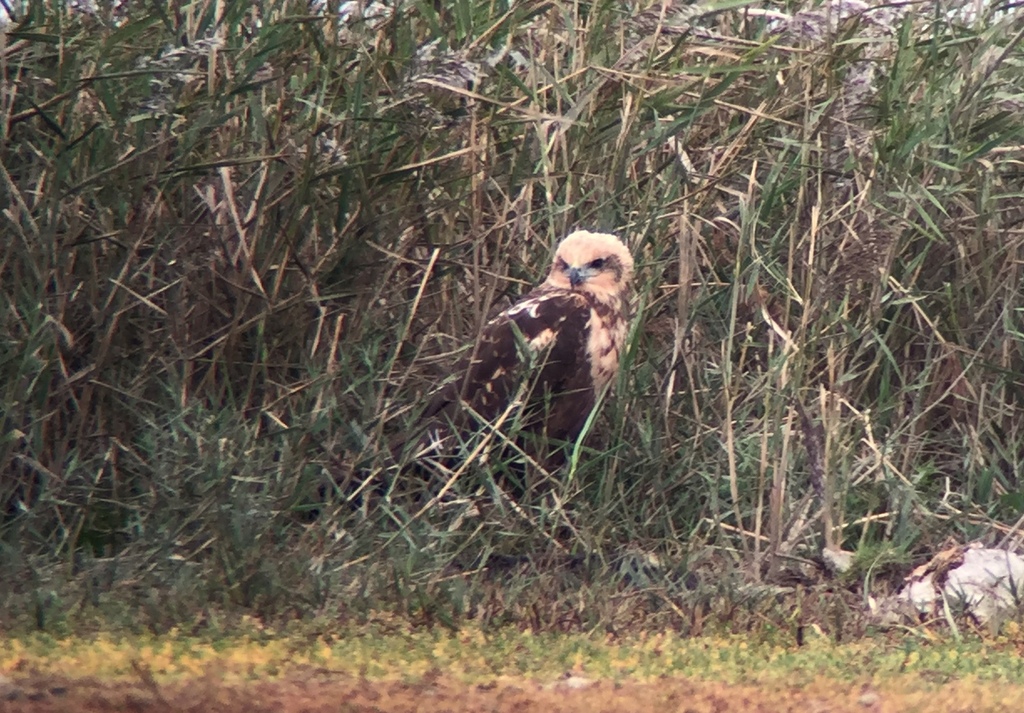 Marsh Harrier – lurking on one of the islands in the middle of Pat’s Pool
Marsh Harrier – lurking on one of the islands in the middle of Pat’s Pool
It was already lunchtime, so we decided to get something to eat and see if any news surfaced on the current whereabouts of the Grey Phalarope. We could have another look for it ourselves afterwards. So while the group walked the short distance along to the visitor centre, the leader went to pick up the car from Walsey Hills. Only half way there, news came through that the Grey Phalarope was back on the pools off the East Bank. Having picked up the car and driven to the visitor centre, the group were in agreement – we should go to try to see the Grey Phalarope before we stopped to eat.
This time we managed to park at the East Bank and we walked straight out. The Grey Phalarope was on show as we arrived, swimming around on a small pool, in and out of the reeds along the edge. Our second phalarope species of the day!
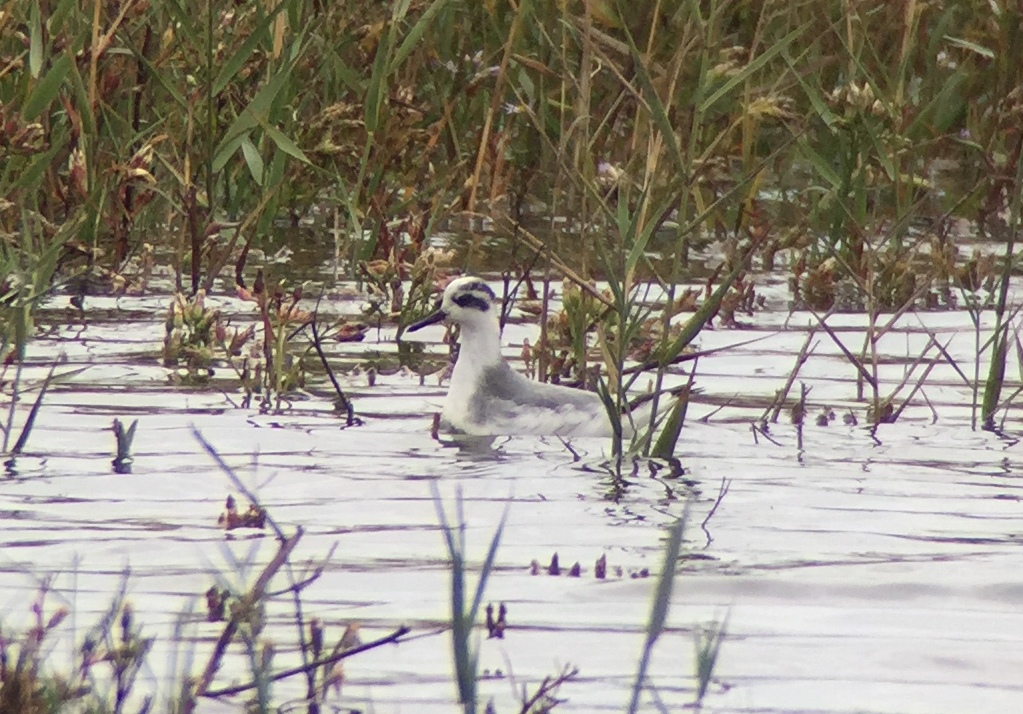 Grey Phalarope – our second phalarope species of the day
Grey Phalarope – our second phalarope species of the day
The Grey Phalarope was rather similar to the Red-necked Phalarope we had seen earlier, swimming around in a similar fashion. However, it was noticeably slightly chunkier and particularly heavier billed. Although it too was born this summer, it was more advanced in its moult, having already moulted its mantle and scapulars to grey first winter feathers.
We stopped on the bank for a while to have a look at Pope’s Marsh. There were lots of Greylag Geese and ducks around the Serpentine, and a careful look through revealed at least six Pintail. They were all in female or dull eclipse plumage, so not looking their best and not so easy to pick out at this time of year.
Their loud yelping calls alerted us to a couple of thousand Pink-footed Geese which came up from the fields up on the ridge behind Walsey Hills. Some headed out onto the reserve but a large group landed down on the grazing marsh behind the Serpentine, where we could get a good look at them through the scope.
 Pink-footed Geese – some of the birds landed on the grazing marsh
Pink-footed Geese – some of the birds landed on the grazing marsh
We were very pleased with our decision to come straight out for the Grey Phalarope, but it was now definitely time to get something to eat, so we headed back to the visitor centre for a rather later than planned lunch. While we were eating, a helicopter flew low over the north side of the reserve, flushing all the geese and ducks from the Eye Field and Billy’s Wash. We looked over to see it was the same one we had seen flushing all the birds from Stiffkey Fen earlier, and it appeared to be just a charter helicopter, not an emergency or survey aircraft. Surely there was no need to fly low up and down the coast like this, flushing all the birds from several conservation areas? Was this just irresponsible flying?
 Helicopter – flying low up and down the coast today over several reserves
Helicopter – flying low up and down the coast today over several reserves
After lunch, we headed round to the beach. We had a quick look at the sea, but it seemed to be fairly quiet, just a few Gannets in the distance. There were a few people seawatching by the beach shelter and someone shouted ‘large shearwaters’. We quickly looked across to see just two dark juvenile Gannets flying past. A single Red-throated Diver flew past too, and a couple of lone Teal and Wigeon, presumably just odd birds returning from the continent for the winter.
We made our way along the beach to have a look out at North Scrape. When we arrived, there were several waders right at the front – mostly Ruff, but a juvenile Curlew Sandpiper was with them. We had a good view of it through the scope, before the waders all flew a little bit further back.
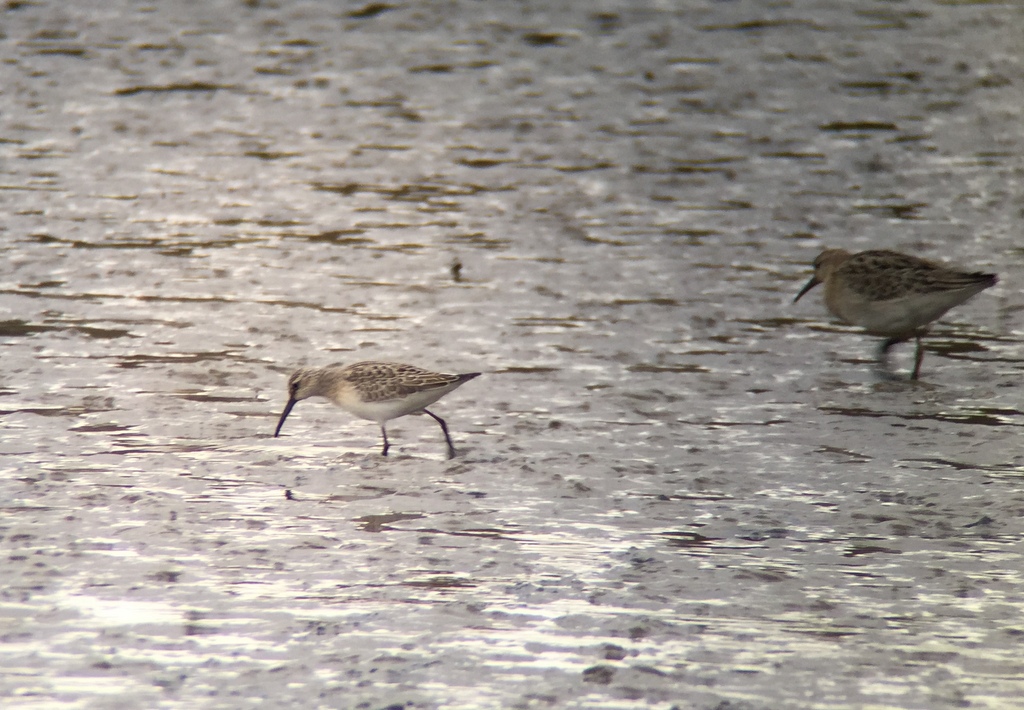 Curlew Sandpiper & Ruff – feeding on the mud on North Scrape
Curlew Sandpiper & Ruff – feeding on the mud on North Scrape
Scanning the rest of the birds on the scrape more carefully then, we found another two juvenile Curlew Sandpipers further over. Otherwise, it was mostly ducks on here – lots of Wigeon and Teal and a few Shelduck. There were several more Ruff hiding in with them.
As we made our way back along the beach to the car park, a line of sixteen Brent Geese flew past over the sea, more fresh arrivals coming back from Russia for the winter. A group of small waders flew in off the sea too, three Ringed Plover and a single Dunlin.
It had been forecast to rain earlier in the afternoon, but had held off until now. However, as we got back to the car, it started to spit with rain. It was not too hard and it eased off again as we made our way back west to Warham. We parked and walked down along one of the lanes towards the saltmarsh. The wind had picked up and it started to rain again. The hedges and fields along the lane were very quiet.
When we got out onto the edge of the saltmarsh, it was rather exposed. There was not much immediately in view – just a few Brent Geese, Curlews and Little Egrets. A quick scan revealed a flock of Golden Plover hunkered down out in the middle, very well camouflaged against the saltmarsh vegetation. Time was getting on now anyway and we had enjoyed a good day, so we decided to call it and head back to the warm and dry.
















